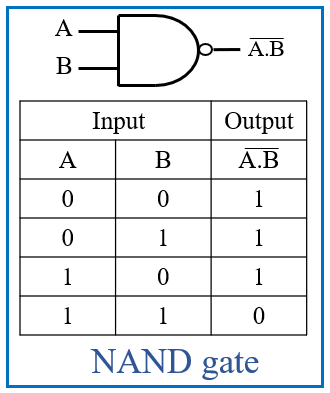- Logic gates serve as fundamental building blocks that execute logical operations on binary inputs, resulting in binary outputs. These gates form the foundation of digital circuits, playing a pivotal role in the processing and manipulation of digital information.
- A Truth table provides a systematic representation of potential input combinations alongside their respective outputs for a given logic gate or logical expression. In this table, each row signifies a distinct set of input values, with the corresponding output determined by the behavior of the logic gate.
- Following are the types of Logic gates:
- AND
- OR
- NOT
- NOR
- NAND
- XOR
- XNOR
- Let’s delve into the specifics of each logic gate:
1] AND Gate:
An AND gate features a single output and multiple inputs. When all inputs are high (1), the output is high (1). The Boolean logic is expressed as Y = A.B for two inputs, A and B. The AND gate is represented by the following symbol and truth table:

2] OR Gate:
The OR gate accepts two or more inputs and produces one output. If at least one input is high (1), the output is high (1). The mathematical expression for a two-input OR gate is Y = A + B. The OR gate symbolizes its logic, where the output is high when any input is high. The OR gate is represented by the following symbol and truth table:

3] NOT Gate:
The NOT gate is a single-input, single-output gate. It produces the inverse of its input, and its Boolean equation is Y = A’. It is also known as an inverter. The NOT gate is represented by the following symbol and truth table:

4] NOR Gate:
A NOR gate is formed by combining an OR gate followed by a NOT gate. The output is high only when all inputs are low (0). The Boolean statement for the NOR gate is Y=(A+B)’ if there are two inputs A and B. It can serve as a universal gate for implementing OR, AND, and NOT.

5] NAND Gate:
A NAND gate is essentially a Not gate followed by an AND gate. The output is low only when none of the inputs is low (0). If there are two inputs A and B, the Boolean expression for the NAND gate is Y=(A.B)’. The NAND gate is known as a universal gate because it may be used to implement the AND, OR, and NOT gates.

6] XOR Gate:
The Exclusive-OR or ‘Ex-OR’ gate is a digital logic gate that accepts more than two inputs but only outputs one value. If any of the inputs is 1 the output of the XOR Gate is 1. If both inputs are ‘1’ the output is ‘0’ If both inputs are ‘0’ the output is ‘0’.
The Boolean equation for the XOR gate is Y=A’.B+A.B’ if there are two inputs A and B. The XOR gate is represented by the following symbol and truth table:

7] XNOR:
The Exclusive-NOR or ‘EX-NOR’ gate is a digital logic gate that accepts more than two inputs but only outputs one. If both inputs are ‘1’ the output of the XNOR Gate is ‘1’ If both inputs are ‘0’ the output is ‘1’ If one of the inputs is 0’ the output is ‘0’. If there are two inputs A and B, then the XNOR gate’s Boolean equation is: Y=A.B+A’B’. The truth table shows that its outputs are based on NOR gate logic. The XNOR gate is represented by the following symbol and truth table:

Exploring the intricate world of logic gates has unveiled the fundamental building blocks of digital circuits. We’ve navigated through the functions of AND, OR, NOT, NOR, NAND, XOR, and XNOR gates, unraveling their symbolic representations, Boolean equations, and truth tables. Understanding these essential components is key to mastering digital circuit design. As we close this exploration, let the knowledge of logic gates empower your journey into the realm of digital electronics and circuitry.
No comments:
Post a Comment